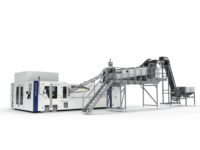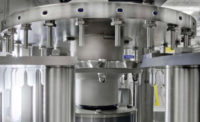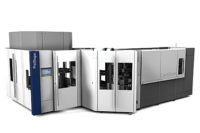Plastic bottle manufacturing adjusts for sustainability
Blow-molding equipment aims to cut materials and costs

Krones’ Contiform blow molder uses an Air Wizard air-recycling stream to recycle the remaining air inside a bottle. (Image courtesy of Krones Inc.)

SIPA’s SFR EVO3 offers energy efficiency through its “green” ovens, which reduce electrical consumption by 40 percent, the company says. (Image courtesy of SIPA North America Inc.)


Approximately 55 percent of the plastic bottles manufactured in the United States are used for beverage bottling, and half of the plastic bottle manufacturing industry’s revenue comes from carbonated soft drink bottles, according to Santa Monica, Calif.-based IBISWorld’s Sept. 2013 report “Plastic Bottle Manufacturing in the US.” In fact, the $13 billion industry is expected to grow by 0.2 percent this year and another 1.9 percent annually through 2018 because of demand from the beverage industry, it states. Therefore, the plastic bottle manufacturing industry is expected to stabilize and grow during the next few years, it adds.
As the plastic beverage bottle market expands, manufacturers are looking for ways to reduce their total cost of ownership and environmental impact while maintaining the flexibility needed to compete in the market, according to Denis Marcon, North American sales director for SIPA North America Inc., Atlanta. This can mean saving energy, producing lightweight containers to save materials, and operating efficiently, he explains.
To help companies meet these objectives, SIPA currently is in the process of modifying all of its machines in order to reduce at least 15 percent of the global impact of material and energy in plastic bottle manufacturing, Marcon says.
Along the same lines, the company also recently premiered new technologies that reduce material and energy use. For example, although there are limits to how thin a preform can be before injection molding becomes impossible, SIPA’s Xtreme machine allows for the production of preforms that are as much as 10 percent lighter than typical lightweight injection-molded preforms without losing any key properties, the company says. To make this happen, SIPA uses injection-compression technology in which the molds are slightly open when the injection starts and then closed when dosing finishes, requiring lower injection pressure and lower clamp force, it explains. By using injection-compression technology, the machine can use preforms that have had extra weight shaved off their bodies and bases to produce plastic bottles that have a length-to-wall thickness ratio of 80, it says.
Also to help reduce energy consumption, SIPA launched its SFR EVO3 stretch-blow molding system for polyethylene terephthalate (PET) bottles in July.
From an efficiency standpoint, the SFR EVO3 can achieve a maximum output rate of 2,250 bottles an hour in each cavity. The various models offer capacities of six to 16 cavities, and 20- and 24-cavity models will be released later this year. Along with this production efficiency, the SFR EVO3 also offers energy efficiency through its “green” ovens and mechanical compensation in the blowing process. The “green” ovens use new lamps and special materials and coatings for the reflectors to reduce electrical consumption by as much as 40 percent while keeping process conditions stable, the company says. For the blowing process, the machine helps reduce air consumption, particularly with smaller bottles, by only using high-pressure blowing on the final fraction of a millimeter of the bottle blowing, as opposed to during the entire blowing process, it adds.
Krones Inc., Franklin, Wis., also has dedicated itself to more efficient air use in the overall packaging chain, including through its Contiform blow molder. “Krones has minimized the amount of redundant, wasted air present within blow molders through continuous design and development of lower-volume valves, lower-volume compensation, and reduced operating air requirements,” explains Adam Stowitts, product manager for plastics technology. Furthermore, the company uses an Air Wizard air-recycling stream, which is operated by the blow molder control system and recycles the remaining air inside a bottle, he says.
KHS USA, Waukesha, Wis., a division of KHS GmbH, offers a similar capability through its Airback Plus development for its InnoPET Blomax stretch-blow molders. This system allows approximately
40 percent of compressed air used in the stretch-blow molding process to be reused in the blow wheel, the company says. In turn, machines equipped with Airback Plus require less energy, less high-pressure air, and a smaller compressor, thereby helping the equipment owner save on investment and running costs, it adds.
The big picture
In addition to achieving materials and energy efficiency, the plastic bottle manufacturing industry strives for overall line efficiency as well. “The reality is brand owners must get products to market as cost efficiently as possible,” Krones’ Stowitts explains. “The solution is to maintain as tight of a production stream as possible while still maintaining enough production volume to keep the materials cost down. … In other words, production should be vertically integrated wherever possible — compact, flexible and efficient.”
To maximize such efficiencies, Krones engineered the Ergobloc system, which integrates a Contiform blower, a bottle filler and a labeler. The system was designed to pro-tect lightweight bottles through positive control and gentle handling throughout the entire bottle manu-facturing process, Stowitts explains. In addition, the system uses a servo-joint control system to control speed and transfers between processes to maximize uptime, he says.
Striving for sanitation
The linking of various machines in the plastic bottle manufacturing process also helps to prevent contamination, according to GEA Process Engineering, Soborg, Denmark. GEA’s ABF system, which couples its aseptic blower with an aseptic filler, includes a microbiological isolator that runs throughout the unit. In this way, a sterile preform enters the microbiological isolator before blowing and remains in the sterile environment until it is aseptically capped after filling, the company said in a statement.
This microbiological isolator has two main sterile components. “At first, we physically separated the dirty mechanical parts from the sterile zone,” the company said in a statement. “Second, we designed every component in the sterile zone to be cleanable with foaming agents and to be sterilizable with vaporized hydrogen peroxide. We then pressurize the environment with a redundant [high-efficiency particulate air] (HEPA) filter station to classify the sterile area in class 100.”
For complete cleanliness, the preforms also need to be sterilized before entering the microbiological isolator, the company said in a statement. GEA sterilizes preforms in one single step with a controlled flow of vaporized hydrogen peroxide after the heating oven. This single-step cleaning helps to prevent cross-contamination, the company explained in a statement. If the external preform is sterilized before the internal section, contaminants from inside the preform can contaminate the outside of the preform as well as any mechanical pieces the preform comes in contact with, it said.
Through these steps, plastic bottle manufacturers can help ensure that they are producing the safest possible product for the beverage market.
Looking for a reprint of this article?
From high-res PDFs to custom plaques, order your copy today!








